Rare octopus nursery found in Nuu-chah-nulth waters
Sixty-five kilometers off the coast of Hesquiat, a deep-sea expedition discovers octopus brooding on their eggs
By Alexandra Mehl Local Journalism Initiative Reporter
Offshore of Vancouver Island, in Nuuchah-nulth waters 65 kilometers west of Hesquiat Harbour, lives a nursery of deep-sea octopuses brooding their eggs. This is one of four known octopus nurseries in the world, said DFO researcher Cherisse Du Preez.

In late May Du Preez and her colleague Heidi Gartner set out to sea on a deep sea expedition, in partnership with the Nuu-chah-nulth Tribal Council, Council of Haida Nation, Quatsino and Pacheedaht First Nation, Ocean Networks Canada and Fisheries and Oceans Canada.


The expedition was largely to explore the pending Marine ProtectedArea Tang. ɢwan-ḥačxʷiqak-Tsigis, alongside additional places of interest to protect, said Du Preez.
Months prior, the German scientific research organization GEOMAR and Natural Resources Canada discovered bubbles traveling 1.5 kilometers through the water column, indicating a methane seep from the seafloor, shared Du Preez. This was the reason they went to the site.
The group explored roughly 12 locations where gases escape from fissures in the ocean floor. There are among the at least 1,500 offshore cold seeps west of Vancouver Island, extending from southern Vancouver Island to Haida Gwaii, said Du Preez.
On their last dive of the expedition, along Hesquiat slope, they came across a nursery of deep sea octopus brooding on their eggs within cave-like features in carbonate rock created by the cold seeps.
“The methane bubbles…that are bubbling out of the seafloor creates large chunks of methane ice,” said Du Preez. “They actually create entire uplifts, and they tear the seafloor upwards.”
She added that this process also “creates carbonate rocks that are then habitat on the seafloor that otherwise weren’t there.”
“It’s almost volcano-like,” said Du Preez. “It’s bringing stuff up from deep within the earth, it’s creating rocks, and it’s all overflowing and then tumbling down and it builds up on itself.”
“In this particular location we saw one of these blisters in the earth’s surface,” she continued. “We saw this violent bubbling coming out, and all the rocks that were being created and tumbling down the slope collected in this boulder field that was otherwise surrounded by desertlike, muddy abyss.”
According to a 2014 study, this particular deep-sea octopus, Graneledone boreopacifica, is known to have the longest-
known egg brooding period of any animal due to the cold temperatures of the deep sea waters. The embryonic development period slows down, compared to shallow water octopus which brood their eggs from one to three months.
“It’s a beautiful deep-sea octopus, very charismatic, purple, big black eyes,” said Du Preez. “[They] sit on their eggs, don’t move, don’t eat and just defend the eggs for a minimum of four and a half years.”
Like salmon, brooding these eggs will be the last thing that these octopuses do, shared Du Preez.
Cold seeps are recognized by the Canadian government to be among ecologically and biologically significant areas.
“They are so standalone outstanding, with the biodiversity you find around them, that they warrant protection,” said Du Preez.
The nursery ground that Du Preez and her team discovered is currently located in an area that is fishable.
“The most concerning thing about finding a nursery somewhere where fishing can happen, is [that] it can be that easy to take out a single generation of an octopus,” she said reflecting on bottom contact fishing.
The crew counted 25 easily-spotted octopuses, though Du Preez said she has “no doubt that there were hundreds more than what we saw.”
Heidi Gartner, a DFO researcher, said that as they moved along the seafloor
in more sandy locations they also saw young octopus close to the nursery.
“It was really good evidence for us that this nursery habitat is really effective,” said Gartner.
Deep-sea octopuses represent the top of the food chain, making them significant to the distribution of energy in the deep sea, said Du Preez.
“When the top predators aren’t healthy, they actually have an effect back on the ecosystem,” she said.
Du Preez explained that octopus living along Hesquiat slope will have an impact on global ocean ecosystems.
“If you didn’t have that nursery ground…you almost couldn’t imagine the ripple effect, if that wasn’t a safe place for the octopus,” said Du Preez. “You might not have that type of octopus anywhere along the NorthAmerican continental slope - all five coasts - because they all come from that one nursery ground.”
Dianne Ignace and her family lives in the small village of Heskwii in Hesquiat Harbour. For the Hesquiaht family, octopuses close to the shore are a common sighting.
“We do have some excitement with [octopus] every now and then,” said Ignace.
Ignace has been told stories from her husband and his father, George Ignace, about at the rocky drop off at the edge to the channel where octopuses could reside, said Ignace.
“Long ago the old timers used to go down there and dig them out,” said Ignace. “They get right in the water, and nobody does it anymore.”
They would eat them, she said.
Oftentimes when Ignace or her family have come across an octopus, it happens in the winter. When they do find them on shore it’s after they have been dropped by an eagle.
“Eagles fly over here with it, and they just lose their grip or somehow the thing wiggles free,” she said. “It drops on the flat, and a lot of times when that happens, the eagles dive down and they start eating it on the beach.”
“Eagles really like to eat octopus because we’ve seen a lot of them eating them,” she added.
Ignace said that once they saw a sea otter laying on its back eating an octopus.
“It fell off a few times too and then the sea otter would dive under and find it again, pick it up again,” she said. “It was really interesting to watch.”
For Gartner, a collective love and connection to octopus can help connect people to the importance of deep-sea conservation.
“Seeing an animal that’s intelligent and with big eyes and living so deep, so remote, so far away from us, and yet, there’s so many elements that you can connect to; it’s just kind of special,” said Gartner. “It’s a great way to connect the deep sea to us.”
First Nations Newspaper - Serving Nuu-chah-nulth-aht since 1974 Vol. 50 - No. 14—July 20, 2023 haas^i>sa Canadian Publications Mail Product Sales Agreement No. 40047776 INTERESTING NEWS If undeliverable, please return to: Ha-Shilth-Sa P.O. Box 1383, PortAlberni, B.C. V9Y 7M2 Inside this issue... Delays allow dealer to keep trafficking..........................Page 3 Ditidaht take control of education..................................Page 5 Coming of age ceremony.....................................Page 10 & 11 Partners work on a vision for Clutesi Haven................Page 14 Nitinaht tourism doing well..........................................Page 18
Canada’s Oldest
Northeast Pacific Deep-Sea Expedition Partnership and CSSF ROPOS photo
Adeep-sea octopus, brooding on her eggs on carbonate rock, uses her dexterous arms to punch and successfully defend herself from scarlet king crabs.
Tseshaht granted $5M to buy land for housing
First Nation looks ahead with the province and city to tackle a ‘housing crisis’ that has escalated in recent years
By Eric Plummer Ha-Shilth-Sa Editor
PortAlberni, BC - In what is being called funding for the first stage of Tseshaht’s large-scale housing development, the province has given the First Nation $5 million for the purchase of land in Port Alberni.
The announcement was made at the base of the Wolf Tower at PortAlberni’s Harbour Quay on July 6, the site of the historic village of ƛuukᵂatquuʔis, where Tseshaht lived in the winter. With the $5 million in provincial funds, the Tseshaht and B.C.’s Ministry of Indigenous Relations and Reconciliation announced that the land purchases will lead to muchneeded housing for the First Nation’s members, as well as others in theAlberni Valley, which is within the First Nation’s territory.

Two blocks away from where the announcement was held stood the Thunderbird Building, a multiple-storey residential, administrative and commercial complex opened by the Uchucklesaht Tribe in 2017. The Huu-ay-aht and Ahousaht First Nations have also began housing developments in PortAlberni for their members, now it’s time for Tseshaht to ensure their people have homes in their territory, said Chief Councillor Ken Watts.
“It’s our time to build housing here in our community,” he said. “I get excited when I think about the potential of 25, 50-unit buildings here in our community, here in our Ḥahuułi of PortAlberni for our people.”
For years PortAlberni marketed itself
as one of the West Coast’s most affordable communities. But from 2015 to 2020 the average purchase price of a residence spiked from well under $200,000 to over $300,000, according to the city’s most recent Housing NeedsAssessment. Meanwhile vacancy rates dropped under five per cent over the same period.
“We are in a housing crisis in the Alberni Valley, like so many other communities as well, but what we have here are willing partners willing to take on a challenge and really make a difference,” said Mayor Sharie Minions.
With 1,186 members, 461 Tseshaht live on reserve, according to the most recent data from the Nuu-chah-nulth Tribal Council, while many others reside within PortAlberni’s city limits. The First Nation is currently designing a subdivision expansion on its reserve for 35 potential units, but there are limitations to onreserve development.
“The overcrowding has been happening for years. We haven’t built a home for a number of years,” said Watts. “We’re running into issues on reserve. We have 100 hectares of land that’s in our research and scanning area for theAlberni Indian Residential School. That’s basically put a moratorium on all of that property until we’ve scanned it.”
The First Nation has identified the need for 200 more homes for its community, but the Tseshaht hope to be part of Port Alberni’s future housing plans.
“[M]ore than 1,000 additional subsidized dwelling units are needed to provide affordable housing for residents,” stated the city’s Housing NeedsAssessment.
Aworking group with representatives from Tseshaht, the city and the provincial government has been formed “to ensure a coordinated, collaborative and informed approach to tackling the housing crisis,” stated a joint press release from the First Nation and the Ministry of Indigenous Relations.
“Five million dollars is enough to purchase land, but it’s not going to be enough to build,” said Murray Rankin, minister of Indigenous Relations and Reconciliation, of the Tseshaht’s housing plans. “They had in mind a $50-million commitment, we don’t know whether that’s going to be sufficient, maybe it’s more than enough, but we’re going to work together.”

Watts said that the additional funding is in place, and that the Tseshaht are already in discussions with one private landowner. The First Nation plans to establish a non-profit housing society as well as a
market rental company. On July 6 another $150,000 was committed by the province in capacity funding to help Tseshaht hire people to refine their housing development plans.
“The funding is already there, quite frankly, it’s about us organizing our society, our non-profit housing society and really getting our infrastructure set up,” said Watts. “If we can get 200 built utilizing this $5 million to purchase various properties, that would be awesome.”
Meanwhile provincial officials and the First Nation have met regularly to develop a reconciliation agreement. Rankin describes these talks as an alternative to a treaty, prioritizing long-term economic development, along with education, health care and child welfare initiatives.
“If Tseshaht wants a constructive arrangement outside of treaty, we’re willing partners in that,” said Rankin. “They’re very big on trying to find work and economic opportunities, investment opportunities, because they want to address some of the social issues that exist in their community and in PortAlberni.”
“We want to reconcile some of the things that have happened in the past for Tseshaht and find a path forward,” noted Watts. “This is a sign of good faith that we’re moving forward in a good way.”
Mid Island-Pacific Rim MLAJosie Osborne was also present at the announcement, noting the irony in Tseshaht needing to buy land in its own territory.
“I will point out the irony of purchasing lands, essentially giving back to the rightful owners of these places - the people who have cared for these lands and these waters and people for millennia,” she said
Page 2— Ha-Shilth-Sa—July 20, 2023
Ken Watts
Despite multiple seizures, court delays allow dealer to keep trafficking for years
By Alexandra Mehl Local Journalism Initiative Reporter
PortAlberni, BC - Nearly four years after his first arrest, Josef Brodek has been convicted of drug trafficking and illegal possession of firearms and sentenced to 10 years. The total amount of drugs
RCMP seized from Brodek amounts to enough potentially fatal doses for the entire population of PortAlberni, reads a statement from the PortAlberni detachment.
2019 was when RCMP first arrested Brodek and searched his residence, finding “significant amounts of drugs, three firearms and over $100,000 in cash.”
But despite a charge, he was permitted to be back on the streets. In 2020 another search warrant was conducted when 3,000 single uses of methamphetamine and a large amount of other drugs were seized, reads the statement. Then in 2022 he sold drugs to undercover police officers three times, and another search warrant was conducted when they located a “wide array of drugs.”
Overall, RCMP seized over $115,000 in cash, more than 13,000 individual doses of methamphetamine, 3,000 units of cocaine, nearly 2,600 units of GHB, and over 1,100 units of Fentanyl, with other pills and illicit drugs. Two more firearms were found alongside a wedding ring from a break and enter.
Constable Richard Johns said in an interview with Ha-Shilth-Sa that in a small community like PortAlberni, it is not often that they see controlled substances and cash at this amount.
“The amount of controlled drugs that were seized here is large enough to have provided a possible lethal dose to the entire population of PortAlberni,” Johns told Ha-Shilth-Sa.
“Once the search warrant would be conducted… all the items will be processed and samples will be taken from all the suspected drugs that would then be forwarded off to the lab to be processed and determined exactly what’s in there,” he explained. “In that meantime, a person tends to be released into the community.”
Johns said that, in his experience, from the time of arrest to when lab results and reports from experts come in, it takes roughly a year for the matter to be before the courts.
In this case, Brodek was sentenced nearly four years after his first arrest.
7 years for Clifton Johnston’s murder
Two years
2nd-degree murder
By Alexandra Mehl Local Journalism Initiative Reporter
PortAlberni, BC -A17-year-old male has been convicted for the second-degree murder of Clifton Johnston, anAhousahtmember and former resident of Port Alberni, who was found deceased outside the PortAlberni Friendship Center in March of 2021.
The
Johns said that this is likely due to delays in the legal system and laboratory during the pandemic, though, from the start of the last investigation with Brodek in 2022, it took roughly a year before he was before the courts.

arrested Josef Brodek at his home in 2019. report, in 2022 theAlberni-Clayoquot region death rate from illicit drugs was 80.9 per 100,000, nearly double the provincial rate. Since 2016, the death rate in the region has quadrupled from 18.6 per 100,000.
“Even if we place conditions onto someone… not to possess a controlled drug or a weapon,” continued Johns, “it tends to be that in these situations that they’re already not following laws, they’re not going to follow additional laws that are placed upon [them].”
“The way the court system is currently set up, though, is that we have to provide them with the opportunities in order to show the courts that they’re able to abide by conditions that are placed upon them,” he added.
Johns said that in his opinion, with Josef Brodeck, it was clear to the courts that he could not continue living without” continuing to commit offenses.
“That’s why Mr. Brodek got the sentence that he got,” he said, adding that “despite any slowdowns, or hiccups that might occur throughout other systems”, the RCMP are continuing to work to get illicit drugs off the street.
“And to provide a full report to Crown Counsel and make sure that people are held accountable for the toxins that they’re putting into the community,” said Johns.
According to the Coroners Service
Les Doiron, vice-president of Nuu-chahnulth Tribal Council, said that given the impact that toxic drugs has had on the community, and the volume of narcotics, cash, and guns that Brodek was reported to have, he believes the sentence does not fit the severity of the crime.
“It seems like the judicial system is pretty lenient on these people,” said Doiron.
“It’s killing a lot of our people here on the West Coast,” he said. “There’s no question about that.”
Ten months after Clifton was found, on January 19, 2022 a charge was laid against the then 16-year-old male. He was arrested the following day.
The male, who cannot be named under the Youth Criminal JusticeAct, received a seven-year sentence after pleading guilty to second-degree murder - four years in a correctional facility and three years in the community with release conditions and close supervision, reads a press release from the PortAlberni RCMP.
“We appreciate the public’s continued support as our investigation has continued through the last two years and acknowledge the emotions that have been felt throughout the community as they have waited for today,” said Constable Richard Johns in the press release. “From the start, the PortAlberni RCMP has been dedicated to ensuring all available evidence was submitted in support of a successful prosecution. These efforts take time.”


July 20, 2023—Ha-Shilth-Sa—Page 3
‘Staggering’ amount of narcotics seized, says RCMP, enough potentially lethal doses for the whole of Port Alberni, but a stalled court system took years to convict
Wikimedia Commons photo
PortAlberni RCMPfirst
after the 20-year-old’s body was found outside the friendship centre, 17-year-old gets
Ha-Shilth-Sa newspaper is published by the Nuu-chah-nulth Tribal Council for distribution to the members of the NTC-member First Nations, as well as other interested groups and individuals.


Information and original work contained in this newspaper is protected by copyright and may not be reproduced without written permission from:
Nuu-chah-nulth Tribal Council P.O. Box 1383, PortAlberni, B.C.
V9Y 7M2.
Telephone: (250) 724-5757
Fax: (250) 723-0463
Web page: www.hashilthsa.com
facebook: Hashilthsa Ntc
2023 Subscription rates: $35 per year in Canada and $40 per year in the U.S.A. and $45 per year in foreign countries. Payable to the Nuu-chah-nulth Tribal Council.
Manager/Editor/Reporter
Eric Plummer (Ext. 243)
(250) 724-5757 Fax: (250) 723-0463 eric.plummer@nuuchahnulth.org
Reporter
Denise Titian (Ext. 240)
(250) 724-5757 Fax: (250) 723-0463 denise.titian@nuuchahnulth.org
Reporter
Alexandra Mehl (Ext. 286) (250) 724-5757 Fax: (250) 723-0463 alexandra.mehl@nuuchahnulth.org
Audio / Video Technician
Mike Watts (Ext. 238)
(250) 724-5757 Fax: (250) 723-0463 mike.watts@nuuchahnulth.org
EditorialAssistant
Holly Stocking (Ext. 302)
(250) 724-5757 Fax: (250) 723-0463 holly.stocking@nuuchahnulth.org
DEADLINE:
Please note that the deadline for submissions for our next issue is
Aug 4, 2023
After that date, material submitted and judged appropriate cannot be guaranteed placement but, if material is still relevant, will be included in the following issue.
In an ideal world, submissions would be typed rather than hand-written. Articles can be sent by e-mail to holly.stocking@nuuchahnulth.org
(Windows PC).
Submitted pictures must include a brief description of subject(s) and a return address.
Pictures with no return address will remain on file.Allow two - four weeks for return.
Photocopied or faxed photographs cannot be accepted.
COVERAGE:
Although we would like to be able to cover all stories and events, we will only do so subject to:
- Sufficient advance notice addressed specifically to Ha-Shilth-Sa.
- Reporter availability at the time of the event.
- Editorial space available in the paper.
- Editorial deadlines being adhered to by contributors.
LETTERS and KLECOS
Ha-Shilth-Sa will include letters received from its readers. Letters MUST be signed by the writer and have the writer’s full name, address and phone number on them. Names can be withheld by request.Anonymous submissions will not be accepted. We reserve the right to edit submitted material for clarity, brevity, grammar and good taste. We will definitely not publish letters dealing with tribal or personal disputes or issues that are critical of Nuu-chah-nulth individuals or groups. All opinions expressed in letters to the editor are purely those of the writer and will not necessarily coincide with the views or policies of the Nuu-chah-nulth Tribal Council or its member First Nations. Ha-Shilth-Sa includes paid advertising, but this does not imply Ha-Shilth-Sa or Nuu-chah-nulth Tribal Council recommends or endorses the content of the ads.
ADSS adds Indigenous studies diploma
Dual diploma in Indigenous studies delves into Nuu-chah-nulth history, language
By: Alexandra Mehl Local Journalism Initiative Reporter
PortAlberni, BC - NineADSS students are the first to complete the high school’s Indigenous studies diploma, recognizing their completion of Nuu-chah-nulth language courses and First Nations studies alongside their standard courses. This is the first year that theAlberni District Secondary School is offering the dual diploma program, with additional classes to come.
“[It’s] cool to be recognized for the work we put into learning about our culture,” said Sophia Bill of Tseshaht, who is anADSS graduate with the dual diploma.
“The French immersion students get… recognized for being in French, so I thought it was kind of cool that they do it with our second language there as well,” added Saphia Lauder of Hupacasath, another graduate to complete the Indigenous studies diploma.
Lauder noted that in being the first to graduate fromADSS with the Indigenous studies dual diploma, they are taking the lead for future students.
Bill and Lauder said they hope that the Indigenous studies diploma encourages students to continue to take Indigenous studies courses and that the diploma recognizes culture in the school.
“I’m hoping that we see a few more students next year get the diploma,” said Lauder.
When asked what their favorite part of Indigenous studies was, Bill, Lauder, Hannah Sam of Tseshaht and Natalie Clappis of Huu-ay-aht chimed in to say they became friends through the courses, noting that it’s nice to be around people from their own culture.
Currently,ADSS offers Nuu-chah-nulth language courses for Grade 8, 9, 10, and 11, BC First Peoples 12, and English First Peoples 12, said Jeannette Badovinac, vice-principal atADSS.
Next year they will also be offering English First Peoples 11 and a Carving 11/12 course with a focus on West Coast imagery. In the 2024/2025 school yearADSS will also offer English First Peoples 10, added Badovinac.

Additionally, they are in the process of getting board approval for an Indigenous
Leadership 12 class.
According to the 2023/2024 course planning guide, students who are active in their First Nation community with language studies, dance practice or performing at ceremonies can receive credits towards their Indigenous studies diploma.
“We have so many nations and students from those nations at our school,” said Badovinac. “We want our Indigenous kids to see themselves when they walk into our building.”
“It’s a huge accomplishment for these guys to take - because it’s equivalent to five courses - to focus and get this diploma,” she added, describing the diploma as rigorous.
Jackie Chambers, a student success teacher and co-chair of the Indigenous Leadership Team atADSS, said that when these students chose to study Nuuchah-nulth language, BC First Peoples History 12, or English First Peoples 12, “there was no expectation of a diploma.”

“They chose those courses because they’re interested in [them] and it was something that they really wanted to do,” she added.
Clappis was shocked when she found out that she would receive a diploma for her studies.
“I didn’t know that was something they offered, but I also thought it was really cool that we would get that after taking the courses,” said Clappis.
Chambers noted that these courses have
been offered atADSS for several years without the formality of the diploma.
“Giving out a diploma lets our students know just how much we value their hard work and their achievement,” said Chambers.
Erika Ingram, a language teacher at ADSS, recently moved to PortAlberni.
Prior to her move, she taught at a school in the Okanagan that offered an Indigenous studies diploma for their students.
“I saw how valuable it was for a public school to honor and recognize a focus area for student learning,” said Ingram.
Ingram pitched the idea for the Indigenous studies diploma to Chambers, and the two of them brought it to the Indigenous Leadership Team near the beginning of the 2022/2023 school year. They were met with excitement for formal recognition that values the students’success, said Chambers.
“I think we’ve long understood that there’s different ways of knowing and different ways of learning and different values in terms of knowledge, but that’s not always reflected in our schools,” said Ingram reflecting on the B.C. education system.
“Yet,” she added.
“I think that the next step is really to transform the way schools look to honor that,” she added. “It’s about recognizing not just the student but recognizing the whole community and recognizing that knowledge is valuable.”
Legal Information
Ha-Shilth-Sa belongs to every Nuu-chah-nulth person including those who have passed on, and those who are not yet born.Acommunity newspaper cannot exist without community involvement. If you have any great pictures you’ve taken, stories or poems you’ve written, or artwork you have done, please let us know so we can include it in your newspaper. E-mail holly.stocking@nuuchahnulth.org. This year is Ha-Shilth-Sa’s 49th year of serving the Nuu-chah-nulth First Nations. We look forward to your continued input and support. Kleco! Kleco!
The advertiser agrees that the publisher shall not be liable for damages arising out of errors in advertisements beyond the amount paid for space actually occupied by the portion of the advertisement in which the error is due to the negligence of the servants or otherwise, and there shall be no liability for non-insertion of any advertisement beyond the amount paid for such advertisements
Page 4— Ha-Shilth-Sa—July 20, 2023
Submitted photo
Nine students atADSS are the first to graduate with the new Indigenous studies diploma. Pictured from left to right is Saphia Lauder, Natalie Clappis, Hannah Sam, and Sophia Bill, four of the nine students.
Ditidaht takes control of education jurisdiction
Through a partnership with First Nations Education Authority, community now has final say over curriculum
By Eric Plummer Ha-Shilth-Sa Editor
Nitinaht Lake, BC - This summer the Ditidaht are making another step in self determination, as the First Nation takes authority over the education path that will guide its community school.
Through an agreement made with the federal government, the southern Nuuchah-nulth nation officially took jurisdiction over its education services July 1. This transfer was done in partnership with the First Nations EducationAuthority, a body independent of government that formed a year ago to help Indigenous communities gain control over schools on their lands. The Ditidaht are the first Nuu-chah-nulth nation to partner with the FNEAto gain educational jurisdiction.
Funding for the Ditidaht Community School, which serves approximately 50 students in kindergarten to Grade 12, will still come from the federal government. But this jurisdictional shift will improve the financial support the school receives, according to Chief Councillor Brian Tate.
“The funding for Ditidaht Community School will be the same – if not greater –than school districts throughout the province,” he said during a celebratory event on June 29 in the First Nation’s village at Nitinaht Lake.

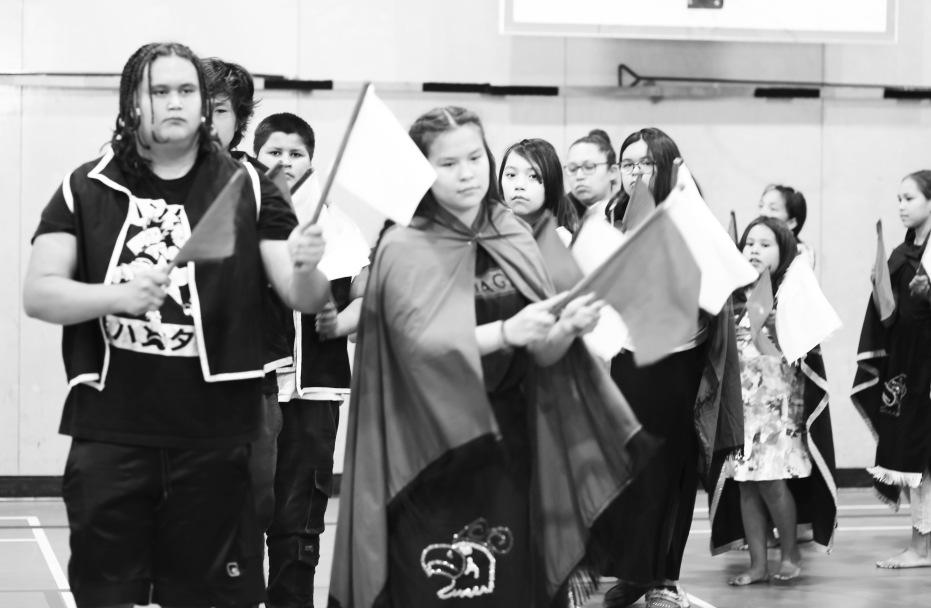
According to the B.C. Ministry of Education, federally funded on-reserve schools are operated by the local First Nations. But officially taking jurisdiction over its school will give the Ditidaht the final say over education as it works with the FNEA. The Ditidaht can now determine teacher certification, curriculum and graduation requirements.

“They have the ability to create a curriculum with culture and language at the forefront, with courses that relate to Ditidaht initiatives – blue collar, whitecollar, legal, office administrators, managers – that’s what these goals are for, so that we all have a helping hand in our way of life in this village and our outside membership to come home,” said Tate.
“Graduates grounded in Ditidaht culture and language, the ability of grads to go anywhere they want in college or university without penalty, that’s what will happen with this jurisdiction.”
Afive-person board of Ditidaht members has been named to guide the direction of its school, and with jurisdiction any laws pertaining to education must have the support of 10 people from the First Nation.
StephanieAtleo is president of the First Nations EducationAuthority and a mem-
ber of the Cowichan Tribes, which gained educational jurisdiction a year ago.
“Jurisdiction is about taking control of your education,” she said. “Only you know what is right for your community, and that’s the power that you’ve taken back from the government, is asserting yourselves in the education your students and your community has.”
The Ditidaht’s village is accessed via a 70-kilometre gravel road running south of PortAlberni, or by a logging road running east to Lake Cowichan - routes affected by blinding dust in the summer and flooding in the winter. Like many remote First Nations, recruiting and retaining teachers is a foremost challenge for the school, but part of the aim of claiming jurisdiction is to gain more flexibility over how educators can be certified. Now existing teaching assistants can be certified as a teacher at the Ditidaht school, said Tate.
“It’s really made a difference in my community to bring the teachers and the principals to the table to talk about teacher certification,” saidAtleo.
Requirements for a Grade 12 Dogwood Diploma will remain the same for the school, with minimum credits needed in phys ed, math, science, language arts and social studies. To earn a Dogwood
students also need to take a math and literacy assessment in Grade 10, followed by another literacy assessment in Grade 12.
During the celebration Robert Joseph, a former elected chief and longtime treaty negotiator for the nation, reflected on how in the early 1970s nearly all of Canada’s First Nation students didn’t finish high school, a time when on-reserve unemployment across the country was 50-90 per cent. Over the years this has improved enormously, but a gap still
remains. In B.C. 88.8 per cent of students finished high school within six years, while the completion rate for Indigenous learners was 69.4 per cent, according to the most recent statistics provided by the Ministry of Education.
“That’s what we’re up against,” said Joseph of the historic gap in high school graduation.
Negotiations for education jurisdiction began in 2007, but the Ditidaht would have gained it years ago if the federal government didn’t get stuck on using the First Nation’s business revenue to fund the school, explained Joseph.
“The confusing part for me is that education costs money, it doesn’t generate money, but they wanted us to pay for it through our own source revenue,” he said. “They wasted a whole bunch of time, there was no way we were going to sign anything like that.”
Former elected chief Jack Thompson was involved in education jurisdiction negotiations from the beginning. For him, the value of education became apparent as a child when his father worked as a logger.
“We’d be sitting around the dinner table, and my father would get home from logging, all wet. He said, ‘Don’t be like me, look at me’,” recalled Thompson. “We can get to the next phase now. We’ve got to build our own personal system that uses the resources that are around us.”
July 20, 2023—Ha-Shilth-Sa—Page 5
Eric Plummer photos
Students from the Ditidaht Community School and others from the community dance for visiting officials at Nitinaht on June 29.
Chief Councillor Brian Tate signs an agreement with StephanieAtleo, president of the First Nation EducationAuthority, next to treaty negotiator Robert Joseph.
Calls for alternative route intensify as delays continue
A 2005 study determined that the Horne Lake Connector, which is on private land, would cost up to $45.5M
By Eric Plummer Ha-Shilth-Sa Editor
PortAlberni, BC - The Ministry of Transportation and Infrastructure has called the Horne Lake connector unsafe for regular traffic, but calls for an alternate highway out of PortAlberni are intensifying as the normal route continues to be compromised by wildfire. Highway 4 was closed for almost three weeks in June as a forest fire burned a mountainside by Cameron Lake, leaving an unstable slope after the route reopened on June 23. To prevent road access from being completely cut off to PortAlberni and Vancouver Island’s west coast communities, a detour route was established on June 7, the day after Highway 4 closed. But the winding route from Port Alberni to Lake Cowichan relied on privately owned and forest service roads that aren’t designed for regular public use, bringing an “essential travel” only direction from the province. While the highway was still closed, a list of local governments and First Nation’s expressed their collective sense of vulnerability due to the reliance on one highway for goods and road transport.

“We are calling upon both the Government of Canada and the Province of B.C. to make immediate investments in securing a permanent access road into the City of PortAlberni as all our local, regional and First Nations governments and organizations rely on this in all aspects of our life,” states the letter, which was signed by the Tseshaht, Tla-o-qui-aht, Huu-ayaht, Hesquiaht and Ditidaht First Nations, as well as the Nuu-chah-nulth Tribal Council, District of Ucluelet andAlberniClayoquot Regional District.

On July 10 PortAlberni city council passed a motion to deliver a similar message, directing its staff to prepare a letter urging the federal and provincial governments “to take immediate action on securing a permanent second access road.”
“We’re probably more remote than we often are aware of as we go about our daily business, and that was brought into focus as we were faced with an emergency such as that,” said Councillor Dustin Dame, referencing the Cameron Bluffs wildfire. “I think it’s past time to reopen that discussion.”
Mayor Sharie Minions noted that the detour route had serious shortcomings.
“The alternative route was not ideal.A lot of people felt uncomfortable driving it, there were several accidents,” she said. “That road was just not a road that I personally felt comfortable driving.”
Minions wants to start a working group with other communities to explore the possibility of a better alternative route.
“We know that there are potentially
Ministry of Transportation and Infrastructure photo
Single-lane, alternating traffic will continue on Highway 4 for the coming weeks, with the added inconvenience of complete road closures on weekdays from 9 to 5.
better access roads and alternative routes that could be activated in the short term,” she said. “I’ve already had conversations with our MLAabout that, and what needs to get done to those roads in order to make them usable.”
The need for a safe alternative road became a common topic of conversation over 20 years ago when railway service to PortAlberni ceased, increasing the use of heavy transport trucks on the Highway 4 mountain pass by Cameron Lake. The Horne Lake connector became the top option up for consideration, a series of forestry roads that branch off the highway east of PortAlberni, leading to a route around Horne Lake that meets Highway 19 near Qualicum.
In 2005 B.C.’s Ministry of Transportation commissioned the Horne Lake Connector Study to determine the viability of upgrading the route for everyday public and commercial use. Extending for less than 30 kilometres east of PortAlberni and around Horne Lake, part of the alternative road would be paved, calculated the study.
“Total costs of the connector are estimated to range from $38.4 million to $45.5 million and are based on a rural two-lane highway standard,” stated the 2005 document.

But as Highway 4 was closed due to the Cameron Bluffs wildfire, the Ministry of Transportation said that the Horne Lake Connector is unsafe for normal traffic due to narrow, winding sections with parts that are steeper than the detour that was in place, according to correspon-
dence with Ha-Shilth-Sa. The connector is currently owned by Mosaic Forests, which allowed some travel for emergency response efforts, stated the ministry.
Bringing Highway 4 back to safe conditions has proved more challenging that anticipated. Before the road was permanently reopened on June 24, the province anticipated that both lanes could be running by mid July. But since then it’s become clear alternating single-lane traffic will continue until at least midAugust, with highway closures weekdays from 9 a.m. to 5 p.m. to allow crews to remove loose rock and trees that were damage by the wildfire. These daily closures started Monday, July 17.
“This work is critical in ensuring the long-term safety of the corridor,” stated the Ministry of Transportation in a press release. “Ageotechnical assessment of
the bluff has determined rock scaling is required before the highway can be safely reopened to two-way traffic at Cameron Lake Bluffs.”
The road will reopen 11:30 a.m. to 1:30 p.m. each weekday to allow waiting traffic to flush through, and no closures are scheduled for weekends.
With the region’s tourism in full swing, the toll of the continued highway delays was acknowledged by Rob Flemming, minister of Transportation and Infrastructure.
“We know that this has been a challenging time for businesses and the tourism sector on the west coast of Vancouver Island, and we thank people for their patience as we work as quickly as possible to get this main corridor safely operating at full capacity again,” he said.
Page 6— Ha-Shilth-Sa—July 20, 2023
Nation’s emergency capacity stressed as wildfire rages
Drought has compounded the risk of lightning-caused fires, bringing an emphasis on emergency preparedness
By Alexandra Mehl Local Journalism Initiative Reporter
This year, before students even closed their books for the summer, forest fires sparked throughout the region.
The Cameron Bluff fire, which is believed to have been human-caused, grew to 229 hectares, closing Highway 4 for most of June - the only highway in and out for many West Coast communities.

One month later, the 16.6-hectare Klanawa River fire was discovered in what Huu-ay-aht Chief Councillor John Jack referred to as the shared territory between his First Nation and Ditidaht.
Though both fires are currently under control, Vancouver Island has reached the maximum drought Level 5 and an “extreme” fire rating, leading the province to prepare for an increase in lightningcaused fires.
According to the BC Wildfire Service, these conditions cause fires to start more easily and spread rapidly, bringing challenges for suppression efforts.
“It’s quite bad right now,” said Nick Donnelly, an information officer with the Coastal Fire Center.
“We haven’t had really much precipitation of note in the last little while,” he added. “Things are just very dry and susceptible to fire.”
“We are anticipating continued extreme fire behavior,” said Bowinn Ma, minister of Emergency Management and Climate Readiness, at a press conference. “All of us need to do our part to prevent the situation from becoming any worse.”
Over the second weekend of July 115 additional wildfires from dry lightning impacted all regions of the province, she said.
Ma said that the recent increased lightning activity was compounded by ongoing drought conditions and high temperatures.
“Human-caused wildfires are completely preventable and divert critical resources away from lightning-caused fires,” said Ma.
“Fire smart your home, clean your gutter, mow your lawn, and make sure anything combustible, such as wood piles, are stored at least 10 meters away from your house,” continued Ma. “It is also important that people are aware of and follow fire bans and prohibitions in their area.”
Effective at 3 p.m. July 10, the Ministry of Emergency Management and Climate Readiness declared a prohibition of category one campfires in all areas of the province, with the exception of Haida

Gwaii, announced Ma.
The minister also encouraged all British Columbians to prepare an emergency plan, including a grab-and-go bag with plenty of water.

“Every year it’s scary,” said Paul Sieber, Ditidaht’s natural resource manager at Nitinaht lake. “I personally am afraid that we’re going to get one close to our community one day and we really are not prepared for it.”
Sieber explains that there are limited routes in and out of the community.
“There’s only the road to Duncan and the road to PortAlberni… [and] there is one more road, we call it the backway,” said Sieber.
“We actually have to do a lot of work for all our emergency planning,” he added. “But due to that is a lack of capacity and funding.”
Chief Councillor Jack notes Huu-ay-aht has similar capacity issues.
“It seems those capacity issues often get in the way of doing good work,” said Jack. “It’s not that there’s no goodwill, it’s that we only have one or two members of our administration, in our tribe or others, that have the expertise to meaningfully participate in some of these conversations.”
Jack said, with emergency planning, capacity issues for First Nations need to be addressed at the provincial level so that
the right people can participate in these conversations - with minimal disruption to other roles these individuals may be taking on.
Protecting the ways in and out of Anacla, a remote Huu-ay-aht village, is important.
“ForAnacla, and any remote village that’s surrounded by Crown lands as well, we do need to have an understanding of the land itself and to be able to make decisions so that we can create firebreaks or get rid of the underbrush in various locations to protect not only the village, or our neighbors in Bamfield, but to protect the only way out, or the only ways out,” said Jack.
Darrell Ross Sr, Tseshaht’s natural resource manager, said that the First Nation

hopes to have more land guardians in the backcountry to help prevent any humancaused fires within their territory.
“It’s kind of alarming because summer hasn’t started yet, and how prepared are we for other fires?” said Ross Sr., noting that the Cameron Bluffs fire, which started in early June, resides partially in Tseshaht territory.
As Highway 4 continues to move towards a full reopening, “crews will undertake essential rock scaling on the hillside affected by wildfire along Highway 4,” reads a statement from the Ministry of Transportation and Infrastructure.
Starting July 17, highway closures are scheduled for 9 a.m. to 5 p.m., with a traffic opening from 11:30 to 1:30, daily. Weekends will remain single-lane traffic.
July 20, 2023—Ha-Shilth-Sa—Page 7
B.C. Wildfire Management Branch photo
In early July the 16.6-hectare Klanawa River fire was discovered in what Huu-ay-aht Chief Councillor John Jack referred to as the shared territory between his First Nation and Ditidaht.
TSESHAHT MARKET GATEWAY TO THE PACIFIC RIM Hours of operation - 7:00 am - 10:00 pm Phone: 724-3944 E-mail: claudine@tseshahtmarket.ca Find us on Facebook
Port Alberni’s tiny home village nearly complete
Federal minister visits Port Alberni site, as pressure grows for more funds to help ‘ground zero’ of drug crisis
By Eric Plummer Ha-Shilth-Sa Editor
PortAlberni, BC -Acollection of 20 tiny homes is nearly complete to house people in PortAlberni’s poorest neighbourhood, and the facility’s operator hopes to have them ready this summer.
Finishing touches are being put on the living units within the Walyaqil Tiny Shelter Village, which is being operated by the PortAlberni Friendship Center with funding for at least two years secured from the provincial government. The friendship centre hopes that people can move into the units by the end of July, as staff will be ready to manage the site by the middle of the month, but an office building still needs to be assembled. Like the 20 living units, the office panels are being built in the Vancouver area before they are sent to the village’s FourthAvenue location for assembly.
Using a word from the Nuu-chah-nulth language that means ‘to be at home’, Walyaqil offers 20 eight-by-12-foot insulated units, equipped with heating and air conditioning. With a painting by Mowachaht/Muchalaht artist Patrick Amos on the wall, each unit offers a bed, small fridge and table. Bathrooms and showers are available in a separate building on the site.
Cyndi Stevens, executive director of the PortAlberni Friendship Center, said that the units are about eight feet apart, mitigating the spread of fire.

“One of the reasons these units took so long to build is because we hired an architect and had inspections to make sure that they’re safe, specifically around fire,” she said, adding that much of the components are fireproof, and windows are kept small to prevent the spread of a blaze. “We would have loved to have them bigger, but they’re smaller to keep the fire contained.”
The homes have been developed by the local friendship centre, which is working in partnership with the City of Port Alberni, BC Housing and the Canada Mortgage and Housing Corporation. The city bought the land for the units to be erected, leasing the site to the Port Alberni Friendship Center.
This arrangement developed amid concerns over a collection of trailers sitting next to Walyaqil, old RVs owned by Randy Brown, who has a local property management company and the next-door WintergreenApartments. Citing bylaw contraventions and safety concerns, city council passed a remedial action requirement in November 2020 for the trailers to be removed, but they have remained as PortAlberni struggles with a housing shortage.Accommodation in the trailers has been rented for $375-500 a month, but Brown has committed to removing them once the tiny home village is available to his tenants.
At least two people have been killed in the WintergreenApartments over the last
year, one fatally stabbed in December, the other dying in a fire in May that also displaced 14 others. Many residents of the building remain without a home.
Stevens said that staff will be at Walyaqil around the clock, working to keep residents safe.
“All of our team members will be supporting each unit to make sure that each unit is safe,” she said. “They’ll be doing checks on them quite frequently. We won’t be allowing anything with fire in each unit.”
Just one person will be permitted to spend the night in a unit, and guests must leave by 10 p.m., noted Stevens. The overall aim is to provide people with a supportive transition in their living situation.
“There’s always going to be this need of transitioning,” said Stevens. “We’re not going to just be a place for them to live, we’re also going to be a place that offers education, support, counselling, cultural support, food and all of that. It’s really about transitioning them to the next phase.”
While new, safer homes are coming to PortAlberni, the community continues to be “ground zero” of British Columbia’s opioid crisis, says MP Gord Johns. He reported that last year PortAlberni saw an overdose fatality rate that was double what occurred across the Island Health region.
“Between the ages of 19 and 44, we’re almost five times the provincial average of toxic drug deaths - in the worst province for toxic drug deaths per capita in the country,” he said. “In PortAlberni there’s no detox. You have to go to Nanaimo to get detox, and then you have
Les Sam Construction
to wait, and then there’s a massive gap between detox and treatment. More often than not, treatment is in Maple Ridge.”
The Walyaqil site can accommodate 10 more living units, but funding is needed for this expansion. On July 4 Carolyn Bennett, Canada’s minister of Mental Health andAddictions, visited the site to assess how it will help the overdose crisis’toll on PortAlberni’s homeless community.

“All of the friendship centres across the country would love to be able to do something like this for First Nations, Inuit, Métis living in urban centres,” she observed.
Many affected by the issue have questioned why a detox facility isn’t available in PortAlberni, but Bennett responded to say that a complex variety of supports are needed to stop more deaths.
“Quite often, the 28-day program hasn’t worked. People need longer programs,” she said. “We are building the kinds of puzzle pieces that fit in so that every jurisdiction can do what they know they need to do.”
Earlier this year Bennett took part in announcing that B.C. is the first province to be granted an exemption under the Controlled Drugs and SubstancesAct, decriminalizing the possession of small quantities of illicit drugs.
“I think that we’re trying to teach people that this is trauma-informed approach,” she said. “Certain people have to numb themselves out of the pain, whether it was child abuse, or they fell off a roof and then got cut off their meds and went to the street for their drugs. People require our love and our care, and not jail.”
Page 8— Ha-Shilth-Sa—July 20, 2023
Residential . Commercial & Architectural Structures Construction Management & Consulting Forming & Framing Ph/Txt: 250.720.7334 les sam@shaw.ca
Eric Plummer photo
On July 4 Carolyn Bennett, Canada’s minister of Mental Health andAddictions, met with Cyndi Stevens (centre), executive director of the PortAlberni Friendship Center, and MPGord Johns at the nearly completed Walyaqil Tiny Shelter Village.
Ditidaht painters lay primer for mural in Duncan
Malinski Painting donated four days to help start a truth and reconciliation project in the downtown district
By Alexandra Mehl Local Journalism Initiative Reporter
Duncan, BC - Over the Canada day weekend, Malinski Painting, a Ditidaht owned company based in the Cowichan Valley, was hard at work volunteering their time to lay down a coat of primer for a mural project organized by the Cowichan Intercultural Society.
For four days, the team donated six to seven hours of their time to have the wall ready for Cowichan mural artist Charlene Johnny. Braiden Malinski, owner of the company, said it was really important for him to be involved in the project.
“If you have a skill or a talent that can help the community, then you should be able to provide that,” said Malinski. “It was a no brainer for me. I didn’t think of money for that, I thought of the opportunity and how I could help.”
“That’s how my staff were too,” he added.
Both Malinski and his employee, Charles Johnson of Ditidaht, said it was an honor to be involved in the mural project that represents truth and reconciliation.
“The importance of truth and reconciliation is pretty big for us,” said Malinski.
“We grew up very cultural, growing up in Nitinaht.”
“I felt very happy as I was there,” he added. “It didn’t feel like work. It was exciting to be able to do something that I’m good at and help people.”
Malinski and Johnson, alongside a small team, laid down one coat of primer on the approximately 45 to 50-foot wall, he said.
Malinski started his business roughly
to lay a coat of primer for a truth and reconciliation mural to be completed in downtown Duncan by Cowichan artist Charlene Johnny at the end of this month. four years ago, and in 2023 was voted number one painting company for the Cowichan Valley by CommunityVotes.

“I try to create a space where we can have fun and not take everything so seriously because life is already so serious,” said Malinski.
“Everyday is something fun,” said Johnson, noting that he and Malinski are first cousins.
“I feel very lucky to be able to provide jobs for people that I love, and for family, especially,” said Malinski.
Johnson and Malinski are excited to see the completed mural.
“There’s some really great colors in
there; it’s really going to stand out,” said Malinski. “The meaning behind it is beautiful as well.”
Johnny arrived shortly after the primer was laid, and began to stencil the design on the wall. On Tuesday, July 11 she began painting and is aiming to complete the mural for Friday, July 21.
She took her own ideas, alongside concepts advised by Cowichan elders to create a mural design that encapsulates the themes of being truthful with feelings, reconciliation, the past, present, and future, said Johnny.

“I think it is a huge honor,” said Johnny.
“I think it’s really important for me as an
emerging artist to have the opportunity to be advised by our community elders.”
“It’s important and special to me to be able to do this work for the community,” said Johnny. “It’s healing for me as well.”
Malinski said he foresees painting, helping, and donating time in the future for projects like this.
“I think that’s something that needs to continue to happen, is helping in those areas when there’s such a meaning behind something,” said Malinski.
The mural is located on 221 Jubilee Street in Duncan, B.C.
July 20, 2023—Ha-Shilth-Sa—Page 9
Submitted photo
The Ditidaht-owned company Malinski Painting donated four days of time
Coming of age ceremony finds modern relevance from
A†@ic`tuu>a was held for three young Huu-ay-aht women on July 15, drawing upon lessons passed through the generations from a
By Eric Plummer Ha-Shilth-Sa Editor
Anacla, BC - For one day this month three young Huu-ay-aht women held the highest position in their nation, the latest effort in a cultural revival movement to restore the respected roles females traditionally held in Indigenous communities.

With broad smiles 12-year-old Eden Dennis, Taylor Williams, also 12, and 10-yearold Mariah Chief were brought into the House of Huu-ay-aht in a canoe by fellow members of their First Nation, as others danced in regalia around them. The procession began their ʕictuuła (pronounced eights too ltha), a coming-of-age ceremony that was once held for all female members of the First Nation after they had their first moon cycle. With over 100 in attendance, the event was held inAnacla on Saturday, July 15.
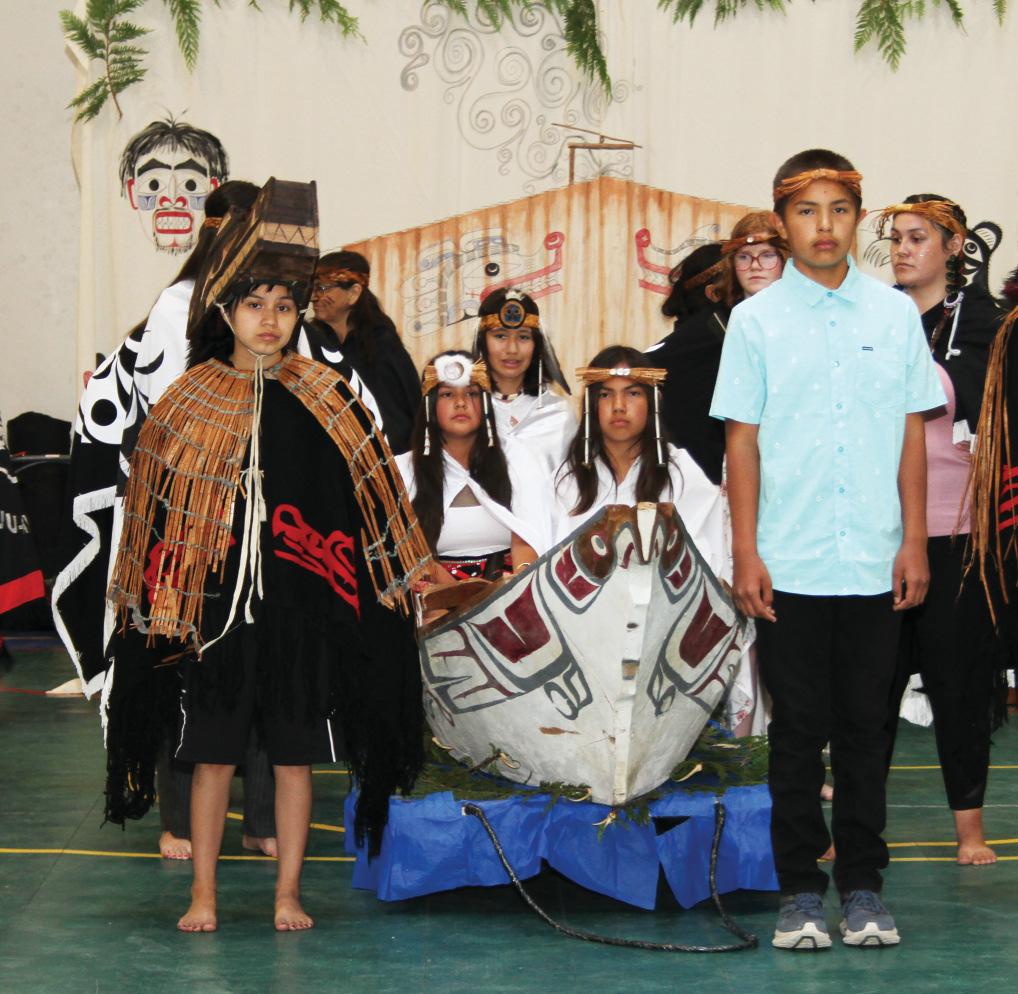
“I started this because my youngest daughter is in that transformation phase right now, and I opened it up to some of my nieces if they wanted to take part,” said Eden Dennis’father Wishkey, who is now known as Kiskiista after receiving a new name at the ceremony. “Historically it was an opportunity to teach them the roles of womanhood - the matriarchs, the moms and the grandmas - to provide lessons on womanhood. It’s all centred around that and to hold them up, to honor them because they are the life givers of mother earth.”
Dennis, Williams and Chief were also given new Nuu-chah-nulth names at the ceremony, as were their mothers. Following the ʕictuuła tradition, on this day the young ladies were placed a position above hereditary chiefs. In recognition of this, three Ha’wiih from the Ditidaht, Hu-ay-aht and Ka:’yu:’k’t’h’/Che:k’tles7et’h’First Nations knelt down to wash the young women’s feet, using water from a carved cedar bowl.
“It’s an opportunity for us as men and fathers to proclaim for the world that, ‘My daughter means something, my daughter means a lot and I want to protect her, I want her to be honored and valued and respected’,” said Kiskiista.
“We do our best to ensure that no harm comes to them,” added Robert Dennis Sr.,
Eden’s grandfather. “It’s our duty as a community; not just one person, we as a community have the shared responsibility.”
Mary Fontaine is a Presbyterian minister
and the founder of Hummingbird Ministries, which promotes healing amongst Indigenous people by helping to repair a broken relationship with churches and
Canada. She believes that the loss of coming-of-age ceremonies has contributed to a degradation in how Indigenous women are valued in Canada, a societal

Page 10— Ha-Shilth-Sa—July 20, 2023
On July 15 Eden Dennis, Taylor Williams and Mariah Chief were honoured with a coming-of-age ceremony inAnacla, where performances and ceremony noon at the House of Huu-ay-aht. Dennis, Williams and Chief are pictured seated in a canoe (below left) after being brought into the house with a procession. ceremony was the washing of their feet by Ha’wiih (below centre).
relevance from ancient traditions
through the generations from a secret ceremony that was held a century ago
become Canada.
“He was working with the Innu people of Labrador. He said, ‘We will have to teach these savages how to treat their women’,” she recalled. “The Europeans came here with the culture of women are less than men, but that wasn’t the traditional view of Indigenous people.”
In the 21st century the prevalence of Aboriginal women and girls who are murdered or go missing has persisted to being considered a nationwide epidemic, prompting the National Inquiry which concluded in 2019.After three years and $53.8 million in federal funds, the National Inquiry found stories of tragedy across the country from every First Nation, with testimonies from 1,484 loved ones and 83 experts. National statistics from 2021 show that Indigenous women are victim to homicide at a rate over five times that of non-Aboriginal females.
Fontaine reflected that violence was not common amongst many First Nations before colonization took its toll.
“When I think about the violence in our families, I think of that, because there was no violence like that. Women were respected. Women were raised and honored as life givers,” she said, adding that this went for child rearing as well. “You weren’t allowed to raise your voice at children because it spoils their spirit. Being put in residential school, not only did they raise their voice, they raised their hand at the children.”
Coming-of-age ceremonies followed the potlatch ban in 1884, with an amendment to Canada’s IndianAct in 1895 that outlawed “any Indian festival, dance or other ceremony.” In 1914 dancing was outlawed off reserve, then in 1925 Indigenous dancing was banned entirely.

Although these prohibitions have long since been lifted, their legacy remains throughout Nuu-chah-nulth communities, which rarely hold ʕictuuła for young women. Fortunately, Kiskiista’s grandmother had a ceremony secretly done for her in 1917, and the protocol passed through the generations.
recreate that.”
Cory Howard from Mowachaht/Muchalaht was also able to assist, as he recently had a ʕictuuła for his daughter.
“All of us need to respect women, whenever we need to talk to them,” he said. “When we see them going down the wrong road, maybe we steer them back into the right path.”
Asong that Howard composed was performed at the recent ʕictuuła inAnacla, a piece he created while thinking of his mother.
“When she was a little girl, her grandmother used to call, ‘Morning Sunshine’ when she got up in the morning,” said Howard of the inspiration for the song.
“My mother wanted to start bringing back coming of ages.”
Now those behind the recent ʕictuuła hope that Huu-ay-aht can hold a ceremony for coming-of-age women every year, building upon the revival of traditions that have been lost to so many over the last century.




“It was never lost completely, it was just dormant, sleeping for a little while. Today is the day that we wake up our ancestral calling,” said Kiskiista. “We’re never going to go back to the way that we lived before contact, but we’re never going to be just Canadian citizens. It’s like we have one foot in our ancient spirit and one foot in our modern mind.”
Fontaine
“They were essentially doing it underground, in hiding,” he said. “Fortunately for us she told us over and over again what kind of things they did, so we are able to
July 20, 2023—Ha-Shilth-Sa—Page 11
Eric Plummer photos Anacla, where performances and ceremony filled the afterbeing brought into the house with a procession. Part of the casualty of the forced assimilation that came with colonization.
recalled the words of a Jesuit priest from the early days of what would
With over 100 in attendance, cultural performances filled the afternoon, following protocol that was outlawed until the mid 20th century.
Hupačasath and logging company celebrate heritage
Two pieces carved from cedar found on Mosaic’s land reference traditional importance of Mount Arrowsmith
By Denise Titian Ha-Shilth-Sa Reporter
PortAlberni, BC – It has been a year since Mosaic Forests opened ʕaʔuk ʔaama kanis, the Loon Lake Campground, and the company marked the occasion by unveiling sculptures they commissioned from Hupačasath artist Rodney Sayers.
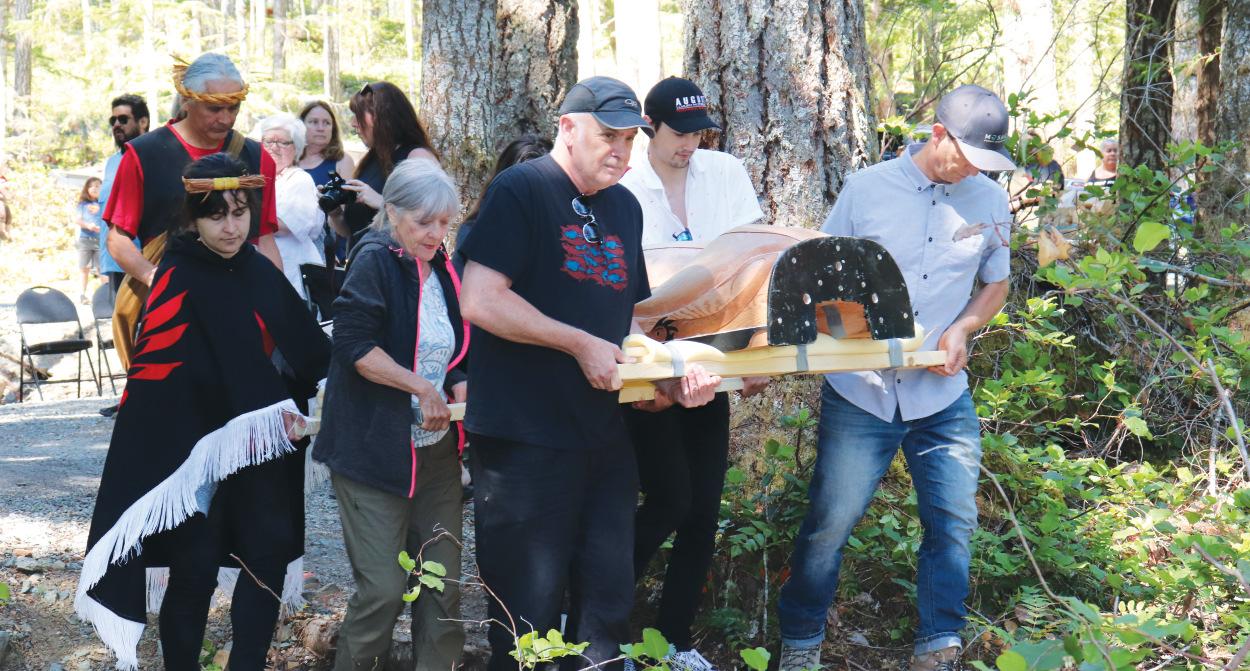
The celebration took place on July 1, at the edge of Loon Lake with the majestic MountArrowsmith looming over the other side of the water. Dozens of people walked down a short dirt path to the edge of the lake where the sculptures would be erected.
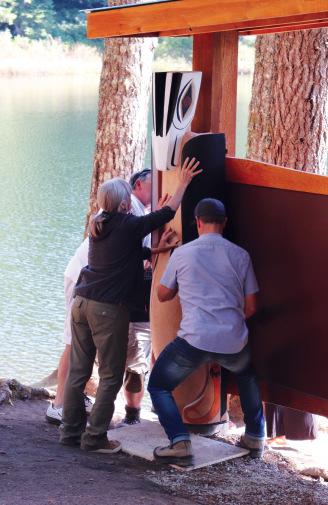
Rod Sayers thanked the crowd for coming. He noted that he had many people to thank, since the creation of the sculptures required teamwork.
The first sculpture features a tiitskin, or Thunderbird, with a grey whale and lightening snake. Pointing to MountAr-
rowsmith, Sayers said his people know that it was Thunderbird that dropped a whale on the mountain. This was proven when whale bones were discovered on the mountain, Sayers explained.
It was important for Sayers to incorporate a reference to MountArrowsmith in his work, saying that the mountain represents Hupačasath’s eastern boundary.
According to Mosaic Forests, the sculptures were commissioned to frame the Hupačasath welcome kiosk, providing cultural information to the campground’s visitors. Mosaic donated the western red cedar used to create the sculptures.
The second sculpture features two loons, a “twoonie”, Sayers joked. The loons stand over a frog which is a reference to the supernatural.
It took twelve people to carry each pole down to the kiosk where they would stand, overlooking the lake.
“When they are lifted, I let them go… they are yours now,” Sayers said to the
crowd.
He said Mosaic and Hupačsath commissioned the poles but they belong to all that come to the lake.
Singers and dancers performed Hupačasath songs beforeAhousaht elder Moy Sutherland chanted a prayer he learned from his late father.
Sayers publicly thanked special guests after the sculptures were erected. Special guests included representatives from Mosaic Forests, Toquaht Tyee HawilthAnn Mack, Hupačasath’s elected chief and council, and Tseshaht Chief Councillor Ken Watts.

Hupacasath Chief Councillor Brandy Lauder said prior to summer 2022, Loon Lake, located near the PortAlberni Summit, was known as a party place, “where people burned palettes.” Now, it’s cleaned up and has several newly constructed campsites with a campground manager on site.
Phrase†of†the†week:†+’uup’aa%a>%iš††c’uumaa@as†hiiq’#a>n’iš††t’uq’kš†i>†
Pronounced ‘Klue pa alth ish stu maa oss he qwalth ulth nish took siltch’, it means ‘It is so hot! Here in PortAlberni. We are almost melting!’
Page 12— Ha-Shilth-Sa—July 20, 2023
Denise Titian photos
On July 1 two sculptures created by Hupacasath artist Rodney Sayers were erected at Loon Lake. It was important for Sayers to incorporate a reference to Mount Arrowsmith in his work, saying that the mountain represents Hupačasath’s eastern boundary.
Supplied by ciisma.
Illustration by Koyah Morgan-Banke
Tseshaht athlete wins two medals at Special Olympics
Jolyn Wa s brings home gold from 1,500 metres and bronze from 4x400-metre relay races at event in Germany
By Sam Laskaris Ha-Shilth-Sa Contributor
PortAlberni, BC – Tseshaht First Nation’s golden girl is back home.
And Jolyn Watts is ecstatic she is now a world champion.
Watts, who is 28, competed at the recent Special Olympics World Games, which were staged June 17-25 in Berlin, Germany.
Watts participated in three track and field events in Berlin.And she ended up coming home with a pair of medals.
For starters, she was the gold medalist in the women’s 1,500-metre race at the C level.Athletes were divided intoA, B or C divisions based on their previous best times they had submitted to games’ organizers beforehand.
Watts also earned a bronze medal as she was on the Canadian women’s 4x400-metre relay team that placed third in its final. Watts also participated in her women’s 800-metre race. But she was disqualified from that event as she did not remain in her lane for as long as she was required to.
Watts, who was competing in her first international competition, was especially thrilled she was able to have a strong finish in her 1,500-metre final to garner the gold medal.
“I was in third place (on the last lap),” she said. “And then I passed the two that were ahead of me.”
And her reaction when she realized she had become a world champion?
“I got excited,” said Watts, who took up running about eight years ago.
Watts is a member of PortAlberni Local, a Special Olympics club that has been offering athletic programming in the community since 1984.
Her local coach Mike Riddalls did not attend the event in Berlin, instead a national team coach was assigned for all of the Canadian track and field participants at the games.
Watts was able to set a personal best time of nine minutes and 30.04 seconds
Mike
Tseshaht First Nation member Jolyn Watts won two medals, including a gold in her 1,500-metre race, at the Special Olympics World Games in Germany. in her 1,500-metre final. She shaved about a minute off her previous best time.

“I’ve seen her run that fast in spurts before but not the whole race that fast,” Riddalls said.
Riddalls added Watts undoubtedly benefitted from a rigorous training schedule.
“She did a lot of cross-training,” he said. “I think she was busy seven days a week.”
Besides her regular track practices with Riddalls, Watts was also swimming twice a week and doing spinning sessions on a bike. She also stayed active by bowling regularly.
The summer version of the Special
Olympics World Games is staged every four years. The games also offer a winter version, every four years. But those are held two years after the summer games. The Special Olympics feature athletes that have intellectual challenges. Those with physical challenges are also welcome to compete.
Canadian athletes selected for the World Games are traditionally chosen following national competitions. But because of the COVID-19 pandemic, Special Olympic national meets were not held in Canada the past few years.
Watts was chosen to be on the national side because of her results at a regional
meet held in Nanaimo in June 2022.
About 90 athletes represented Canada in Berlin. Besides track and field, the World Games featured 15 other sports: badminton, basketball, 3-on-3 basketball, beach volleyball, bocce, bowling, cycling, equestrian, field hockey, football, futsal, golf, artistic gymnastics, rhythmic gymnastics, handball, judo, kayaking, open water swimming, powerlifting, roller skating, sailing, swimming, table tennis, tennis and volleyball.
Watts said that she was able to attend the rhythmic gymnastics competition during her spare time at the games.
Plus, she enjoyed her experience of being in Germany.
“I liked seeing everything different, like the different kinds of stores,” she said. Another highlight for Watts was visiting, with her teammates, the Berlin Zoological Garden, Germany’s oldest and bestknown zoo.
Watts added she was able to make several new friends while overseas. She plans to keep in touch with several of the new people she met via social media.
As for Riddalls, he’s understandably thrilled one of his athletes was able to win some hardware at a world competition.
“The medals are just part of the story,” he said. “The journey she had is quite incredible. We started training I think in the middle of October and continued to do so until the week before the games.”
Though another meet might pop up before then, Riddalls said Watts’next track event might be next June, at a Special Olympics competition in Nanaimo.
Riddalls believes the fact Watts was able to compete at the World Games will prove to be inspirational for some other athletes at his PortAlberni club.
“I hope so,” he said. “The Special Olympics are all about competition and training and having fun. I do think (Jolyn’s participation in Berlin) will inspire some of our other local athletes to get to the national team.”
Team BC starts strongly as NAIG unfolds in Halifax
Team BC photo
Team BC had a strong start to the NorthAmerican Indigenous Games, with 29 medals after the event’s first two days of competition.
After the sporting events began in Halifax on July 17, British Columbia athletes won six gold, two silver and two bronze medals after the first two days of competition. This includes two pieces of hardware won by the Canoe Kayak teams, which have competitors from the Ditidaht First Nation.
Hosted by the Millbrook First Nation, NAIG runs until July 23. The athletic event has drawn approximately 5,000 athletes from across Canada and the United States from 756 different Indigenous nations.
Providing an athletic venue for 13-19-year-olds, this is the first NorthAmerican Indigenous Games that have been held since 2017. Team BC earned the most medals at the last two games in 2017 and 2014.

July 20, 2023—Ha-Shilth-Sa—Page 13
Riddalls submitted photo
Tseshaht, Hupacasath, city work on vision for Clutesi
By Karly Blats Ha-Shilth-Sa Contributor
PortAlberni, BC -Amaster plan is in the works that will see new development at Clutesi Haven Marina in PortAlberni.
The Tseshaht and Hupacasath First Nations are working together with the City of PortAlberni on the initial planning phase for the marina, situated on the tidal fresh waters of the Somass River, and along Highway 4.

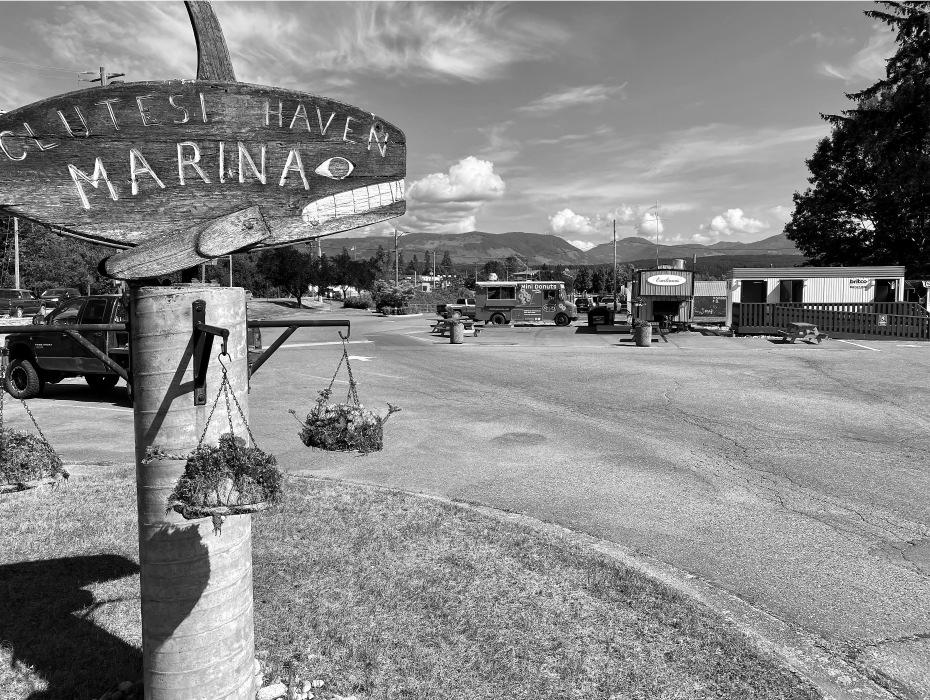
Island Coastal Economic Trust has committed $30,000 to this project through its Investment Readiness Program’s Regional Collaboration stream. Initial planning includes community economic development initiatives and land use while building respectful and sustainable government-to-government partnerships.
“This funding is assisting our three governments to work together to bring our vision for Clutesi Haven to a reality,” said Hupacasath First Nation Chief Councillor Brandy Lauder in a press release.
To help capitalize on the highly visible piece of property that sees up to 1.6 million people drive by each year, the three governments established a working group and are envisioning how the area can be best redeveloped to benefit all community members and visitors.
“Ultimately we decided to prioritize our projects and Clutesi Haven’s…been one that we’ve all wanted to see improvements on,” said Ken Watts, Tseshaht First Nation chief councillor. “It’s the gateway to the west coast, it’s such an underutilized space and both our nations have a keen interest, not just culturally and historically, but economically.”
Although no plans have been made official yet for the space, Watts said ideas from all parties have been introduced and they’ll be working with consultants to have renderings designed.
“There’s some priorities that some people want, like I said artwork is one, supporting local artists and vendors,” Watts said. “But things need to happen in a phased approach.At the end of the day let’s move forward and try to get something approved there.”
In the past, the Tseshaht, Hupacasath and the City of PortAlberni worked together to create a modest visitor and community experience at Clutesi Haven Marina. This included food trucks and Indigenous art on display. While the idea allowed a few families to earn income during the summer months and helped amplify the reach of Indigenous art, the project partners had a clear vision to achieve greater potential.
Watts said all parties agree that having visitors and locals stop at the marina instead of just driving by is a main priority.
“There’s lots of different retail-type opportunities there and other opportunities. The food is already working,” Watts said. “We also need to remember it’s also about looking after our local residents too and providing a nice space for them.”
Watts said the working group has to consider geotechnical issues with the area during the planning phase.
“There used to be a building there, quite a large building…and it was basically sinking from my understanding, so we need to be careful about the infrastructure that’s there,” Watts said. “There’s some access issues getting into the area and parking…so it comes with its challenges,
but I think that’s why we’re working together.”
Watts added that the dog park across the street from the marina, which is largely used by local residents, is also included in discussions but that no official plan has been made for the area.
“The dog park is more of a local space that we could probably find another location for. It’s not the best use of the land, unfortunately,” Watts said.

The new master plan will support the development of the shared land use vision, and the design process for that will take the three partners’working group through a series of project phases to arrive at a consensus vision and robust plan for their respective and collective communities.
This plan will then be integrated into the city’s Official Community Plan. Once those are approved, the partners will move into the second phase of implementing the vision.
“Our past experience was a catalyst to develop our three-year facilitated First Nation-municipal Community Economic Development Initiative (CEDI) program,” said Pat Deakin, economic development officer with the City of PortAlberni in a press release. “It was from here that our workshops and working groups began, and which are today allowing us to embark on this new and collaborative vision.”
The project will be underway imminently.
“Partnerships such as this do more than just bring people to the table, they help foster new ideas, allow for sharing of resources, and build lasting relationships while working towards great outcomes that will benefit so many people,” said Josie Osborne, MLAfor Mid Island-Pacific Rim in a press release. “The Clutesi Haven Marina Uplands site holds so much potential, and I can’t wait to see the final plan for the future of the site.”
Page 14— Ha-Shilth-Sa—July 20, 2023
Partners see untapped potential at highly visible site, which has estimated 1.6 million people drive by annually
Karly Blats photos
View more job postings and breaking news at www.hashilthsa.com
Afew food trucks currently occupy space at Clutesi Haven Marina, where more economic development plans are underway for the site by the Tseshaht and Hupacasath First Nation in partnership with the City of PortAlberni.
First Nations-led coastal corridor established
Nations concerned initiative will dictate what they do in their own territories, but protected corridor proceeds
By Konnor Oliver Ha-Shilth-Sa Contributor
The federal government has announced funding in the amount of $525,000 coming to Vancouver Island, as a contribution to the Indigenous-led Westcoast Stewardship Corridor. The corridor will aim to increase “ecological and cultural connectivity” along the west coast of the island. Ecological corridors like this one are used to slow biodiversity loss and help species adapt to the changes in our climate. The idea is that, by linking a multitude of protected areas, natural processes are allowed to take place and species can freely move and interact, finding habitat anywhere within said corridor.

“The Indigenous-led Westcoast Stewardship Corridor is a historic initiative that will benefit biodiversity and Canadians for generations to come,” said Minister of Environment and Climate Change Steven Guilbeault in a statement. “By investing in nature and linking areas of rich and diverse habitat, we are allowing species to move freely on the landscape and ensuring their long-term health and well-being while also contributing to the fight against the changing climate.”
The corridor initiative is largely being led by Yuułuʔiłʔatḥ, Toquaht, and T’Souke Nations, with input being sought from 13 total First Nations existing in the area identified for the corridor. The area extends from as far south as Saanich and runs along the west coast of the island north to Tahsis.
“We know we have disrupted the forest, the house of the wildlife, and we would like to be part of restoring ‘the house’. We need to be able to have all living beings living in a healthy way and
we can learn from our ancestors how to restore the land. That is our birthright,” said Chief Gordon Planes of the T’Souke Nation.
According to a Research and Communication Report from 2022 from the Indigenous-led Westcoast Stewardship Corridor, one concern mentioned by a number of the nations was having an external land vision imposed on their traditional territories.
“What nations do in their territories is their business, it’s not up to us say what others can and can’t do. We feel the same way about others thinking about us,” Chief Councillor Ken Watts from Tseshaht said in the report. “We won’t be told what to do.”
Another concern was making sure that the right people are involved in the leadership team of the corridor.
“Just on principle alone, working with people who are going to inherit the land, it is getting us set up for best practices,” said Saya Masso of Tla-o-qui-aht First Nation in the 2022 report.
While not all concerns have been sorted out yet, the leadership team for the corridor is taking steps to make sure they are addressed. The scheduled next step will be a gathering hosted by the T’Sou-ke Nation in November of this year.
The federal government launched the National Program for Ecological Corridors inApril of 2022. Since then, they have contributed more than $5 million to similar projects such as the Forillon Ecological Corridor in Quebec, as well as the Cootes to Escarpment EcoPark System Ecological Corridor Pilot project and the Algonquin toAdirondacks Collaborative, both in Ontario.
Strathcona RD receives funding for climate disasters
By Alexandra Mehl Local Journalism Initiative Reporter
The Regional District that encompasses Campbell River, the Homalco First Nation, Ka:’yu:’k’t’h’/Che:k’tles7et’h’
First Nations, K’ómoks First Nation, Nuchatlaht First Nation, Gold River, and Sayward received over $1.1 million from the Community Emergency Preparedness Fund to strengthen its resilience against climate-related disasters.
Through the CEPF, the province is providing over $44 million in funding to be allocated among 70 projects in 63 communities throughout British Columbia under the Disaster Risk ReductionClimateAdaptation program, reads a provincial press release.
“With the severe flooding, drought and wildfires we’ve experienced recently, we are seeing direct impacts of climate change here in B.C.,” said Bowinn Ma, minister of Emergency Management and Climate Readiness in the press release.
“We’re investing in mitigation projects across the province so we can reduce the risk of disasters when they happen. These projects will help communities better protect themselves against climate-related events and increase their resilience in the long run to keep people across B.C safer.”
According to a staff report provided by the Strathcona Regional District, among the number of projects to be funded are the Houpsitas Watershed Restoration Project and the Nootka Island Ecological
Restoration Strategy. Both projects will include a watershed risk assessment and a stream restoration design with aims to support “long-term solutions that reduce the impact of disasters” and develop engagement with the respective First Nation, reads the document.
For Ka:’yu:’k’t’h’/Che:k’tles7et’h’First Nation, located in the Strathcona region, emergency preparedness is important due to how remote they are, said Emergency Preparedness Coordinator Elizabeth Jack. “We’re three and a half to four hours from the closest city, which is Campbell River,” said Jack. “We don’t have the luxury of having a hospital or walk-in clinic or doctor here 24/7.”
When asked about the importance of funding for emergency preparedness, Jack shared that through partnerships with SRD and the Holistic Emergency Preparedness and Response the First Nation has been able to achieve grants for projects that have helped the its emergency program, such as Tsunami sirens, an evacuation plan as well as emergency sea cans and supplies (blankets, pillows, and dried food etc.).
According to the Union of BC Municipalities, which administers the Disaster Risk Reduction-ClimateAdaptation funding stream, the program is to reduce risks of future disasters from natural hazards.
Intake for the 2023/2024 Disaster Risk Reduction-ClimateAdaptation program is open until Oct. 6, 2023.
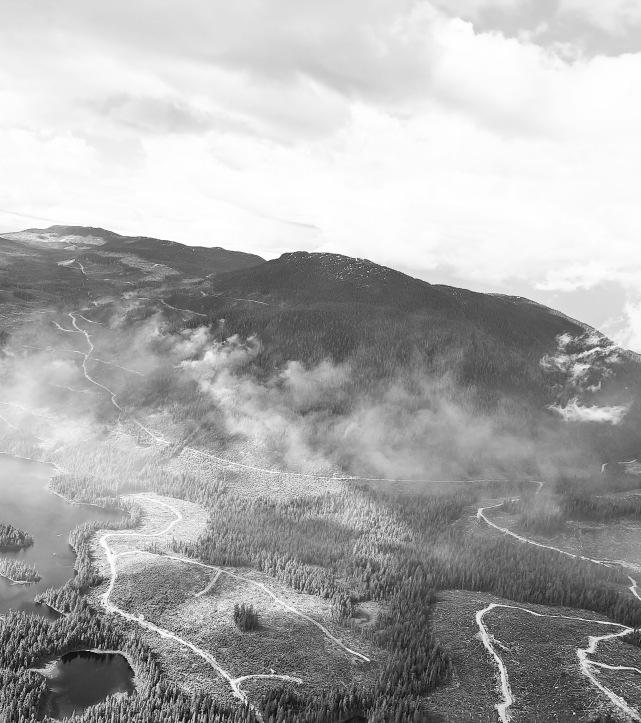
July 20, 2023—Ha-Shilth-Sa—Page 15
Eric Plummer photo
Ahiker walks on Meares Island in the territory of the Tla-o-qui-aht First Nation.
BC Wildfire Service photo
Located at the edge of the Strathcona Regional District boundary, 5.6 kilometres west of Sayward, the Newcastle Creek fire burned to encompass 230 hectares since it was first spotted May 29. The regional district recently received over $1 million in provincial funding to help mitigate future climate-related disasters.
&Community Beyond
NTC Child and Youth Services
Every Wednesday of the summer
Canal Beach
10:00am – 1:00pm Hotdogs, volleyball, kites and cornhole. Bring your family and water bottles.
Women Healing Session
July 30th –August 25th

Kackaamin Family Development Center
Ahealing journey for women who have been harmed through sexual violence. Meals and accommodation are provided. For more information, please contact intake coordinator @ 778-421-8809 or rebuildingthecircle@kackaamin.org
Tseshaht Canoe Family Paddle Practice
Thursdays: June 29th & July 6th, 2023
6:00 am - Meet at Papermill Dam & 7:00 pm - Meet at Clutesi Haven Marina
Dear Corrine,


These are the last 4 paddle practices before we leave PortAlberni and head to the Broken Group Islands on July 14, 2023. Paddles and life jackets provided. Kids under 12 are welcome but must be accompanied by an adult. We are teaming up with the Men & Women’s Youth Warriors groups this year. We are focusing on participants aged 12 to 25. Come on out and have some fun! Please message CoreyAnderson on Facebook for questions or more information.
47th Annual BC Elders Gathering

August 15th – 16th 2023


Vancouver Convention Center
Our Elders possess all the wisdom of the ages – knowledge and experiences that the younger generations need to guide them through life. It is very important that this event continues and that our Elders’legacy is passed on to each generation that follows. With the world we live in becoming increasingly modern by the minute, we need to provide the balance that comes from remembering the past through our Elders lives.
I want to thank you for the handsome boys and beautiful granddaughter you had with my son. They made me wealthier with great-grandchildren, and even wealthier with great-great-grandchildren. Thank you, thank you, thank you –from the bottom of my heart, I love you.
-Chris Jules
Page 16— Ha-Shilth-Sa—July 20, 2023
More events at www.hashilthsa.com
Employment and Training
Port Alberni Friendship Centre Volunteers Needed

Need work experience? The Port Alberni Friendship Centre is looking for interested applicants for various positions. Call 250-723-8281




July 20, 2023—Ha-Shilth-Sa—Page 17
More job postings at www.hashilthsa.com
Nitinaht tourism ‘doing well’, despite highway closure
Lake serves as a destination for kiteboarders, who flock to the Ditidaht First Nation’s newly expanded campsite
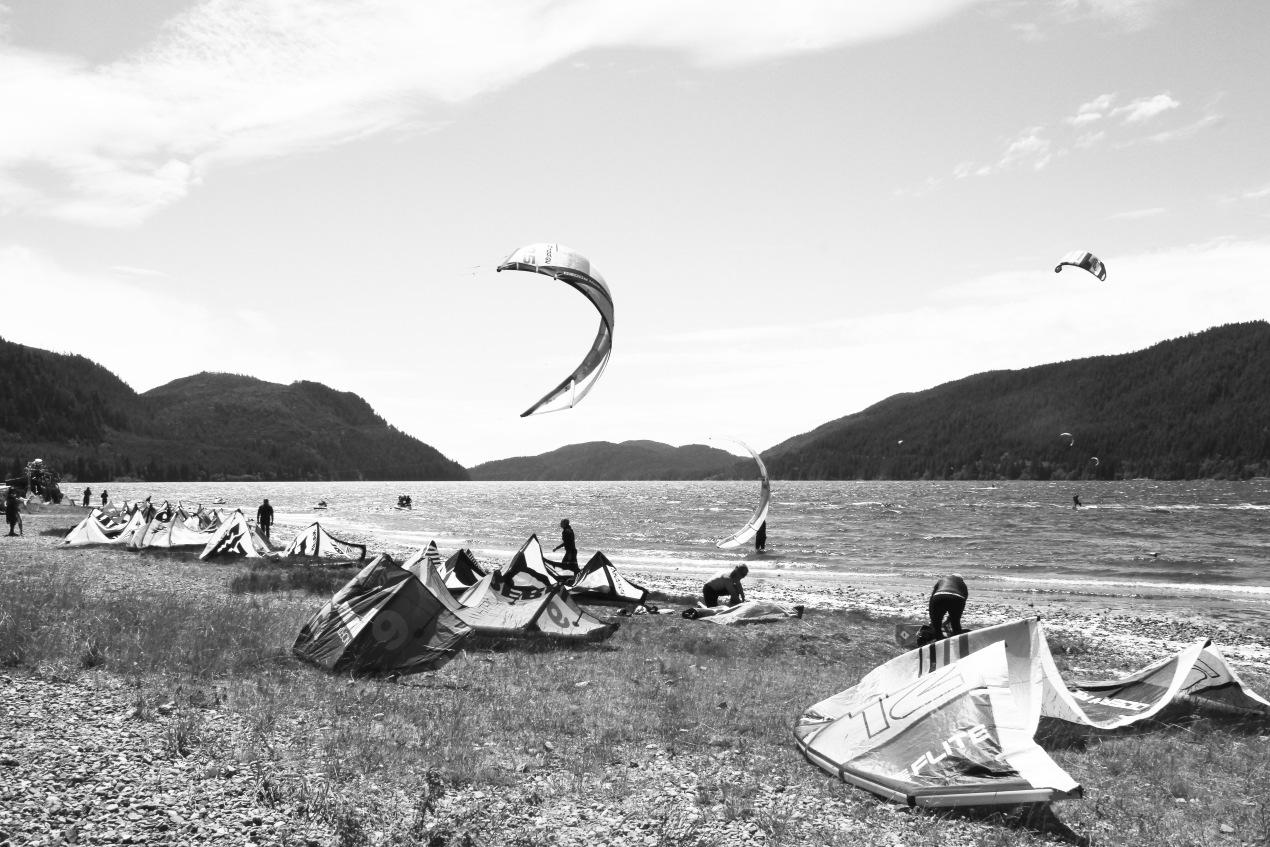 By Karly Blats Ha-Shilth-Sa Contributor
By Karly Blats Ha-Shilth-Sa Contributor
Nitinaht Lake, BC- Tourism at Nitinaht Lake is doing well this season with little to no disruptions caused by the Highway 4 road closure.
Nitinaht Lake is on the traditional territories of the Ditidaht First Nation and is about 60-kilometres southwest of the town of Lake Cowichan.
Bryan Cofsky, executive director of the Ditidaht Development Corporation, said so far this season the Nitinaht Windsurf Park and Caycuse campgrounds, which are the main source of tourism in the region, are “doing well.”
“Kiteboarders are still the majority of our clientele, although with the expanded area and new sites we are attracting more families who are not windsurfers or kiteboarders,” Cofsky said. “We are building six retreat cabins in the woods on the existing Ditidaht Private Lands. It has been a successful Job Creation/WorkBC and training project for local members.”
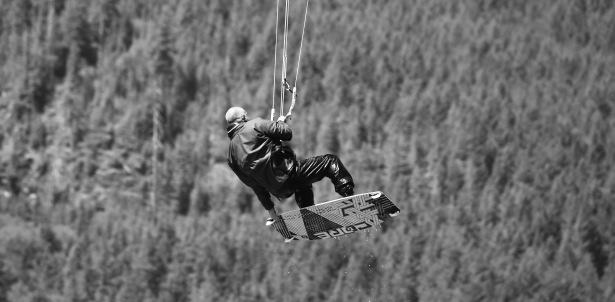

Cofsky said the new cabins should be complete by this September and are funded by the BC government’s Community Economic Recovery Infrastructure Program (CERIP) and Job Creation Partnerships (JCP).
Highway 4 was shut down between Koen Road and Cathedral Grove from June 6 – 24th due to the Cameron Bluffs wildfire.Adetour route was put in place during the highway shutdown that took drivers on a gravel road from PortAlberni to Lake Cowichan.
Cofsky said the highway closure did not affect tourism in the area and in fact increased traffic because the road goes through Nitinaht.
Nitinaht is also the third entry point for hikers accessing the West Coast Trail.
Cofsky said numbers for people accessing the trail through Nitinaht were down slightly this May and June from last year, but he’s noticing July has been getting busier.
Another development at Nitinaht Lake is the construction of a new dock.
“The new dock is presently being installed and will replace the existing one,” Cofsky said. “The usage does not change as it has been used predominantly for member vessels, DFN commercial fishing boats and the West Coast Trail water taxi.”
Page 18— Ha-Shilth-Sa—July 20, 2023
Eric Plummer photos
Kite surfers enjoy the strong wind over Nitinaht Lake on June 29. The lake’s wind-tunnel-like dynamic has made it a renowned destination for the activity.
Master carver opens new workshop in Yuquot

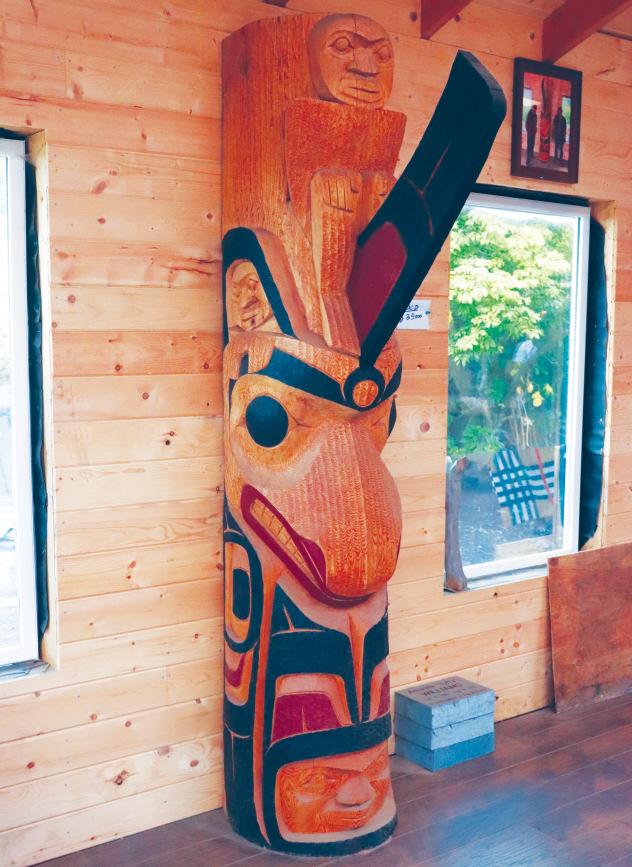

 By Alexandra Mehl Local Journalism Initiative Reporter
By Alexandra Mehl Local Journalism Initiative Reporter
Yuquot, BC - Sanford Williams (Ahtsiksta), master carver of Mowachaht, has been honing his craft for almost 40 years. He started out painting as a teenager and with inspiration from his uncle, Chief DominicAndrew, Williams would begin his journey to becoming a master carver.
“My uncle used to carve all the time in the morning,” said Williams. “That really sparked an interest in me and in my art and my carving world.”
“My mom told me…if you can paint you can carve, also,” added Williams. “I tried carving and then I liked it and never stopped since then.”
Williams said that it means a lot to him to have learned his craft from his uncle and hopes that there are youth that he can pass his teachings too.
“He’s the one that started me in my carving,” said Williams, in reference to his uncle. “He taught me… in the beginning how to split [the wood], [and] how to get it ready for a mask.”
“He was a big part in the beginning of my carving career,” he added.
Throughout Williams’career, he has carved masks, paddles, totems, plaques and murals, doors, among other items.
Roughly a two-hour ferry ride from the Gold River Municipal Docks, on Nootka Island at “the center of the world,” is the Mowachaht village, Yuquot.Along the beach at friendly cove is where Williams has spent three months of the year carving and selling his work to tourists for the past 35 years.
For the last 20 Williams carved and sold his work from his lower shop, down on the beach.
“Being out here in Yuquot,” said Williams when asked what inspires his work.
“I love carving out here because it’s so isolated and quiet at times.”
“That gives me inspiration to do my work,” he added.
Near the beach in Friendly Cove, a newly built shop sits among tall standing trees next to the ocean, only a short distance from the docks.
June 28 marked his grand opening for this new shop, which Williams named after his late-father, Ghoo-noon-tuk-tomith, meaning spirit of the wolf.
Williams was joined by family, Jimmy Johnson Jr, Eddie Jack, DwightAmos,
“I’ll do anything for my uncle,” shared Jimmy Johnson Jr. “It makes me happy to come out here - our other home, our first home - and come and support him on his big day for his grand opening.”
While Williams cut the ribbon in front of his shop, his family sang and danced.
“That’s our victory song,” said Johnson Jr.
“I wanted to come out and show him that we love him,” said Johnson Jr to the crowd that gathered outside William’s shop.
Before William’s father Ray passed away, he wanted his son to have a nice and new shop to carve in, said Sanford. The two of them pitched in and work started on the building.
“It wouldn’t have been possible without my dad,” said Williams to the crowd.
“I’m lucky to welcome all of you to my new shop.”
July 20, 2023—Ha-Shilth-Sa—Page 19
On June 28 Sanford Williams officially opened the facility, named after his late father, Ghoo-noon-tuk-tomith
Hilary Savey, Carmen Savey, and Marge Amos, who traveled to Yuquot to sing songs for his grand opening.
Alexandra Mehl photos
Sanford Williams (Ahtsik-sta) of Mowachaht, a master carver, held a grand opening for his new shop, named after his latefather, Ghoo-noon-tuk-tomith, meaning spirit of the wolf.

Page 20— Ha-Shilth-Sa—July 20, 2023






















































 By Karly Blats Ha-Shilth-Sa Contributor
By Karly Blats Ha-Shilth-Sa Contributor





 By Alexandra Mehl Local Journalism Initiative Reporter
By Alexandra Mehl Local Journalism Initiative Reporter
